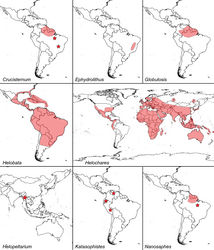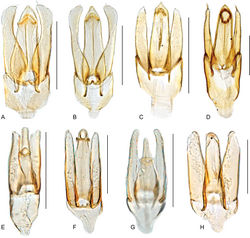Nanosaphes
| Notice: | This page is derived from the original publication listed below, whose author(s) should always be credited. Further contributors may edit and improve the content of this page and, consequently, need to be credited as well (see page history). Any assessment of factual correctness requires a careful review of the original article as well as of subsequent contributions.
If you are uncertain whether your planned contribution is correct or not, we suggest that you use the associated discussion page instead of editing the page directly. This page should be cited as follows (rationale):
Citation formats to copy and paste
BibTeX: @article{Girón2021ZooKeys1045, RIS/ Endnote: TY - JOUR Wikipedia/ Citizendium: <ref name="Girón2021ZooKeys1045">{{Citation See also the citation download page at the journal. |
Ordo: Coleoptera
Familia: Hydrophilidae
Name
Nanosaphes Girón & Short, 2018 – Wikispecies link – Pensoft Profile
- Nanosaphes Girón & Short, 2018: 143.
Gender
Masculine.
Type species
Nanosaphes tricolor Girón & Short, 2018: 151; by original designation.
Diagnosis
Very small beetles, body length 1.15–1.45 mm. Body shape oval in dorsal view; slightly to moderately, and evenly convex in lateral view (Fig. 41). Coloration uniformly brown, to variable along the body; ground punctation shallow to moderately marked (Fig. 41). Shape of head trapezoid and relatively wide. Eyes moderate in size, slightly emarginated anteriorly, not projected from outline of head. Clypeus trapezoid, with anterior margin broadly emarginate. Labrum fully exposed. Mentum with lateral oblique ridges. Antennae with eight antennomeres; cupule slightly asymmetric, with rounded outline. Maxillary palps slender, moderately long nearly 0.7 × the width of head; inner margin of maxillary palpomere 2 nearly straight, outer margin curved along apical half (e.g., Fig. 41C, F). Each elytron with ground punctures usually only shallowly marked, seemingly forming longitudinal rows, with irregularly distributed systematic punctures bearing rather long setae, denser along lateral and posterior regions; elytra without sutural striae. Prosternum flat, at most only weakly convex. Posterior elevation of mesoventrite, usually projected as low and short longitudinal carina between mesocoxae; anapleural sutures only weakly curved, separated at anterior margin by distance nearly 0.9 × width of anterior margin of mesepisternum. Metaventrite with posterolateral and mesal glabrous patches (e.g., Fig. 41C, F). Protibiae with spines of anterior row hair-like, semi erect, relatively long, thick and sparse. Metafemora mostly densely covered by hydrofuge pubescence (e.g., Fig. 41C, F). All tarsomeres with long and thick spines on ventral faces of tarsomeres 2–4; metatarsomeres 2–4 gradually decreasing in size, metatarsomere 5 as long as 3 and 4 combined, 2 slightly shorter. Fifth abdominal ventrite apically emarginate, with fringe of stout setae. Aedeagus trilobed (Fig. 40E–H), nearly parallel sided, with basal piece 0.3–0.6 × length of parameres; median lobe with well-developed lateral basal apodemes, wider at base than base of each paramere, usually narrower at apex than preapical width of parameres; apex of median lobe rounded; parameres from slightly shorter to longer than median lobe, and only narrowing at apex; gonopore situated beyond midpoint of median lobe.
Differential diagnosis
The minute size of Nanosaphes make them smaller than any other Acidocerinae in the New World, and about equal in size to the smallest species of Agraphydrus in the Old World. They are among the smallest water scavenger beetles worldwide. The lack of elytral serial or sutural striae and the antennae with eight antennomeres also separate Nanosaphes from all other Neotropical Acidocerinae genera except the co-occurring Globulosis. Nanosaphes can be easily separated from Globulosis by its smaller size and narrower, more parallel sided body form (broader and almost rotund in Globulosis, Fig. 32).
Distribution
Neotropical: Brazil (Pará), Guyana, Suriname; Fig. 5.
Natural history
Species are associated with stream margins, particularly where there are marginal banks of sand and roots.
Larvae
Immature stages are not known for Nanosaphes.
Taxonomic history
Nanosaphes was only recently described.
Remarks
There are four known species of Nanosaphes, which can be differentiated from each other by external morphological features (e.g., elytral punctation, coloration, shape of the posterior elevation of the mesoventrite), which is somewhat unusual by acidocerine standards. We have seen additional material of Nanosaphes from other regions within the Guiana Shield.
Species examined
Holotypes and paratypes of all known species were available for this study.
Selected references
Girón and Short 2018[1]: original description of the genus and all its known species; Short et al. 2021[2]: phylogenetic placement.
Taxon Treatment
- Girón, J; Short, A; 2021: The Acidocerinae (Coleoptera, Hydrophilidae): taxonomy, classification, and catalog of species ZooKeys, 1045: 1-236. doi
Images
|
Other References
- ↑ Girón J, Short A (2018) Three new genera of acidocerine water scavenger beetles from tropical South America (Coleoptera, Hydrophilidae, Acidocerinae).ZooKeys768: 113–158. https://doi.org/10.3897/zookeys.768.24423
- ↑ 2.0 2.1 Short A, Girón J, Toussaint E (2021) Evolution and biogeography of acidocerine water scavenger beetles (Coleoptera: Hydrophilidae) shaped by Gondwanan vicariance and Cenozoic isolation of South America.Systematic Entomology46(2): 380–395. https://doi.org/10.1111/syen.12467

![Figure 2. Phylogeny of the Acidocerinae simplified from Short et al. (2021)[2], indicating the distribution, preferred habitat, and currently described number of species for each genus. For habitat, filled black circles indicate that at least some species of the genus are commonly found in this habitat; light grey circles indicate the genus has been found in this habitat, but is rare or not typical for the group; white circles indicate no species have been recorded for the genus in this habitat.](https://species-id.net/o/thumb.php?f=Zookeys-1045-001-g002.jpg&width=184)



